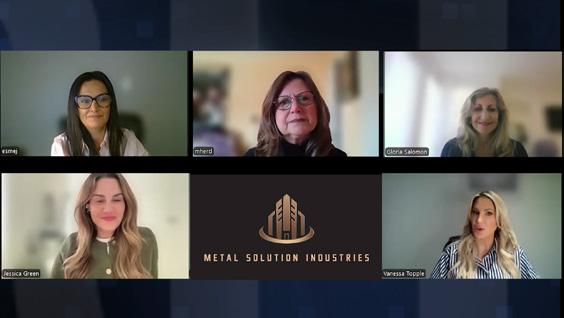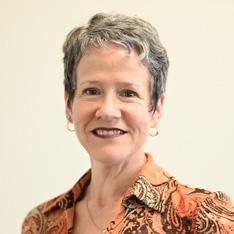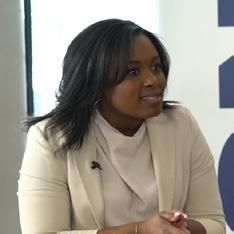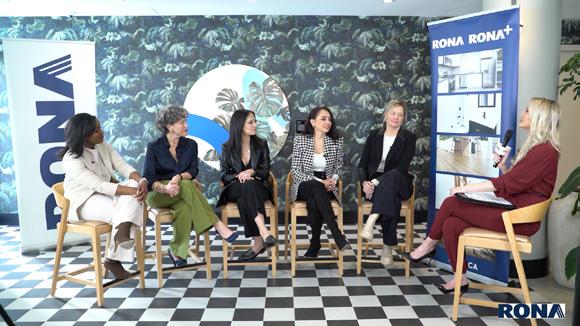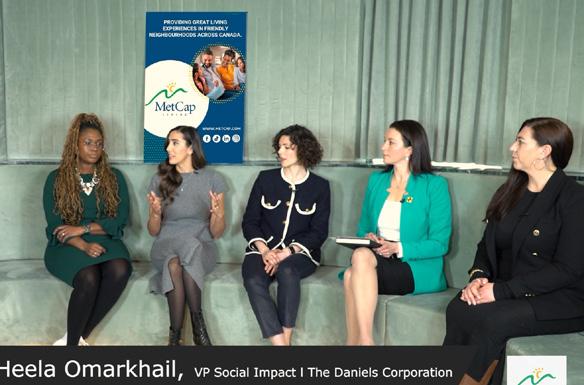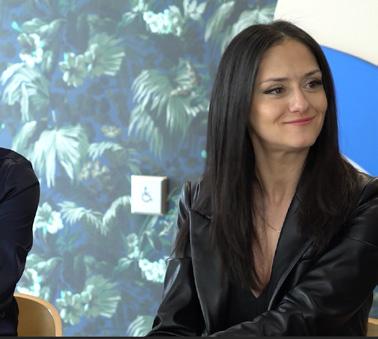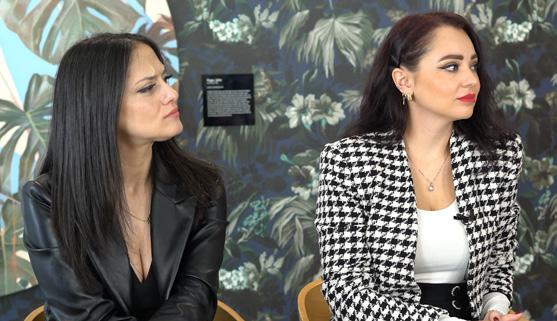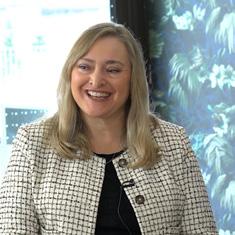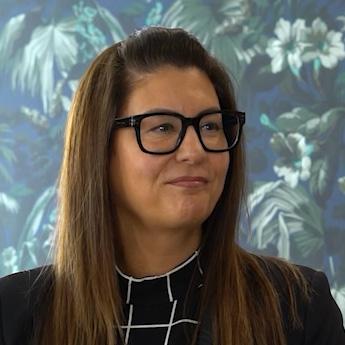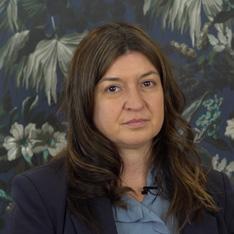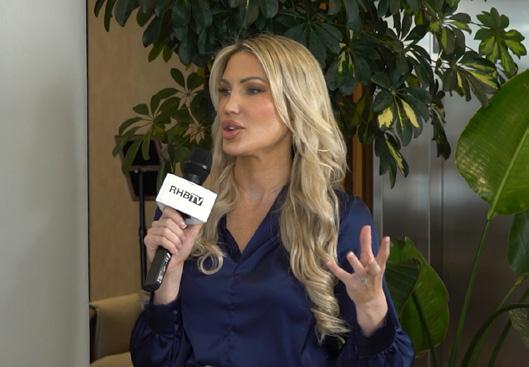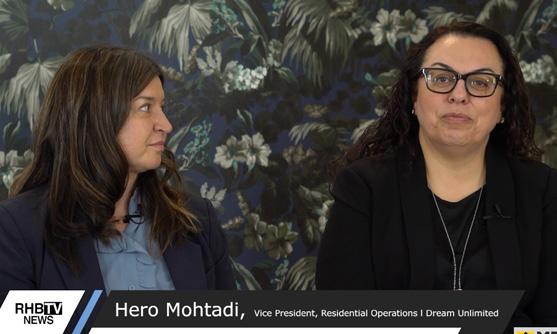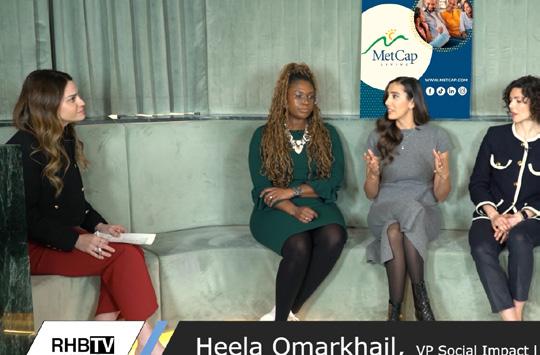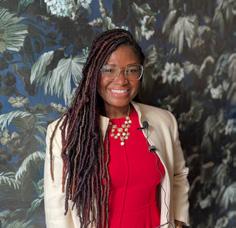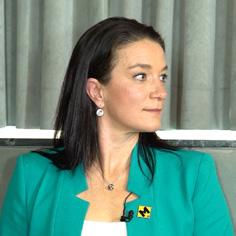International Women’s
By David Gargaro
International Women’s Day (IWD) was on Saturday, March 8 this year. For the last fve years, RHB Inc. has dedicated a full month of events to celebrate IWD. This includes RHBTV hosting several panel discussions with women in leadership roles within the rental housing industry.
Panel 1, moderated by Vanessa Topple, Anchor and Producer of BoldTV, and Jessica Green, Director of Communications with Greenwin, engaged in discussions about what occurred during the other three panels and the behind-thescenes processes involved in selecting the topics and panel members. The panelists included:
Margaret Herd, Retired, Park Property Management
Panel 2 was moderated by Vanessa and involved a discussion on resilience in mental health and wellness. The panelists included:
Gloria Salomon, Chairperson, DBS Developments
Esme Junaid, Regional Director, BC, MetCap Living
BJ Santavy, Vice President, Skyline Living
Ashley Archer Bereaux, Director of Residential Operations, Starlight Investments
Brandi McIlvenny Clarke, CVO, Brandi Clarke Consulting
Parisa Vafaei, Regional Director, Yardi Alina Okhnovska, CEO, Metal Solution Industries
Women’s Day 2025
Panel 3, also moderated by Vanessa, focused on inspiring the next generation of women in the real estate industry. The panelists included:
Hero Mohtadi, Vice President, Residential Operations, Dream Unlimited
Kristin Schulz, HR Director, Park Property Management Inc.
Trish MacPherson, Past Partner, Alignvest
Paula Gasparro, Vice President, Real Estate, CMLS Financial
Michelle Collins, Director of Government and Other Verticals, Rona Canada
Panel 4, moderated by Jessica, took place at the Jade restaurant in Yorkville. The discussion focused on community engagement in the rental housing industry. The panelists included:
Fay Yachetti, Director, Sustainability, Skyline Group of Companies
Heela Omarkhail, VP Social Impact, The Daniels Corporation
Ossana Ber, Community Engagement Manager, Greenwin Corp.
Maegan Fearman, Business Development Manager, Residential Sales, Metro Compactor Service Inc.
Sarah Segal, CEO & Founder, simplyDBS
Going behind the scenes
Panel 1 began with Vanessa explaining how they wanted to show the audience what went on behind the scenes of IWD, including how the panel topics were selected and how they chose who would be on the different panels. The goal was to demonstrate their thought processes and get more women involved in all aspects of putting on the event.
Jessica commended Vanessa and RHB for putting on the unique event, stating she was proud to have been involved with IWD for the past four years. She considered her involvement in moderating the panels “a major career highlight” and was glad to see they were doing something different from previous years with this panel.
On the topic of creating an impactful International Women’s Day discussion, Gloria Salomon stated it was important to understand what was relevant to women and the industry today. Given the changing environment, Women’s Day is a chance to reflect on progress, but also to address the challenges women face. Those challenges can be leadership, inclusivity or mental health, but the topics need to reflect where we are as a society and where we want to go.
Margaret Herd agreed, emphasizing the importance of selecting the right panellists, which is as important as choosing the topics of discussion. Meaningful discussion depends on bringing in and listening to voices with different perspectives and lived lives. She added, “Representation is not about checking boxes, but ensuring people see themselves reflected in the discussions so they can take action in their lives and communities. Representation is the key to ensuring the conversations inspire real change.”
Esme Junaid added the panels need depth, as it’s important to go beyond the trends and headlines. This would enable deeper discussions of relevant topics and allow the panelists (and those who watched the event) to identify real solutions to essential issues.
The panel members also discussed the other panel topics, what made them relevant to women in today’s real estate industry, and the value that would be derived from engaging in these types of discussions.
Mental health and resilience
Panel 2 began with Brandi McIlvenny Clarke discussing the issue of burnout. Although it’s not the same for every person, burnout essentially means being physically, emotionally, and mentally exhausted. While there are many causes of burnout, it comes from experiencing extended periods of overwhelm and stress. The symptoms can manifest themselves in any number of ways. For example, an individual who experiences burnout could feel lethargic or fatigued, experience various physical symptoms like rashes, and even lose interest in things in which they previously found joy. Isolation is also a symptom of burnout, which involves withdrawing from friends and family and turning down work initiatives. Brandi emphasized the importance of discussing burnout, and mental health in general, to ensure people were aware of it to understand the signs and prevent it from happening.
Parisa Vafaei spoke about burnout as it relates to measuring performance. Many people’s duties are quantified, tracked, measured, and compared to benchmarks and key performance indicators. They are expected to hit certain goals in their roles. Employees are experiencing burnout and losing engagement, and their jobs are becoming nothing more than performing tasks and keeping up with expectations. Tasks become repetitive and lose their meaning, and employees lose their purpose and motivation to do the work.
Alina Okhnovska related her real-world experience with burnout, as she had recently launched her own company. She felt the symptoms of burnout both emotionally and physically. She addressed the issues by making time for herself and finding ways to personally deal with stress.
Ashley Archer discussed what companies should be doing to help address employees’ mental wellness, such as providing access to counselling services and employee assistance programs. She encouraged team members to make use of those resources when needed. Ashley spoke about the importance of companies getting to the root causes of workplace stress. Work-life balance is important, but companies must also address serious challenges, such as dealing with a toxic workplace, overcoming the lack of leadership training and supports, identifying and solving the problem of unrealistic workloads, and other issues detrimental to employees’ mental health. Ashley also emphasized the importance of creating an environment where employees feel comfortable talking about mental health, asking for help, and having those types of conversations without fear of being stigmatized.
BJ Santavy added they have an obligation to be the leaders they want to see in the workplace. This means using the influence available to model ideal workplace behaviours. She spoke about the power of storytelling to help create a more inclusive environment and a stronger workplace culture. BJ described a Skyline program that highlights one employee for one hour once a month, which enables them to tell their story in their own words. Employees have spoken about various mental health issues, such as suicide and trauma. They have also talked about the people who influenced them and helped them to get through dark times. These types of programs have helped to normalize the discussion of difficult topics and made it OK to talk to others when you need help.
Parisa added the number one team-related cost is having to replace a member of your team. Therefore, it makes sense to encourage discussions of mental health, as well as take care of yourself. Self-care has tangible benefits to the company. It all begins with leadership. She stated, “If you’re going to ask your employees to be in love with their jobs, they actually have to be in love with their jobs. Otherwise, they’re not showing up on a Saturday, as you would have expected. Chances are they’ll quit.”
Inspiring the next generation
Panel 3 began with Vanessa sharing research on how Generation X and Baby Boomers are coming to the end of their careers. The real estate industry is seeing large numbers of employees retiring, with more of the younger generations coming on board. According to Forbes, by 2030, 30 per cent of the workforce will be Generation Z. Members of this cohort have different expectations from their careers, from the workforce, and from the trajectory of their careers than their predecessors. The goal is to determine what needs to be done
to attract, inspire, and retain the members of this generation to set them up for success and to lead the next generation of employees.
Paula Gasparro stated younger generations are more in tune with their mental health and wellbeing. They’re looking for more work-life balance, as well as more regular work hours (e.g., 8 am to 5 pm, 9 am to 5 pm) so they have more time for a personal life with friends and family. In general, they’re not coming into the office at 7 am and working long hours. They care about their health, as they’re making and eating healthy meals and choosing healthier lifestyles. Paula said this was unheard of when she started her career, and if you wanted this kind of work-life balance, you were not going to move up in the workplace.
Kristin Schulz added the younger generations are more risk-taking. So, if their current situation doesn’t meet their needs, whether it’s the organization as a whole or the role they’re currently holding, they are more likely to look elsewhere for what they want. Salary is an important factor for helping to retain people, and it’s often ranked highly as a deciding factor when choosing to stay with or join an organization. But Kristin said culture is essential, and it’s important for younger employees that the organization and its values are in alignment with their own. If there is no match, then it means they were not meant for that role and organization, and that’s OK with them.
Hero Mohtadi spoke about the importance of starting retention even before the employee joins the firm. It begins during the interview process and forms the foundation of the eventual relationship with the employee. It involves building a connection with the interviewee. Hiring managers must emphasize this aspect when engaging with potential employees. Interviewers are always eager to explain the benefits and elements of a role, but they need to understand this is the time to connect with the individual and understand who they are as a person.
Michelle Collins spoke about connecting younger employees to their peers through mentoring programs. They want to feel connected to the organization, preferably through people within the same generation via social interactions. This requires listening to employees to determine their needs to possibly adapt to what works best for them. It’s also an opportunity to learn from younger employees, as they have different ways of seeing things.
Trish MacPherson discussed the importance of collaboration. There appears to be less separation between different organizational levels than there has been in the past. The barriers between senior leadership and more junior people have
been knocked down, which younger generations of employees seem to appreciate. Having group meetings where everyone is involved and encouraged to provide their input is a true motivator. Younger employees are more willing to say what’s on their mind. However, some are less willing or able to speak up, as they went through COVID and did not have as many opportunities to develop social and communication skills. Creating a collaborative environment can help to encourage more open communication. Trish added that younger employees also want to be valued for their contributions, and for what they say to be heard and implemented.
Community engagement in the rental housing industry
Panel 4 began with Jessica emphasizing the importance of community. Rental housing is more than bricks and mortar; it’s about the people who live there and the connections they build. Engaged communities create safer, more resilient, and more inclusive environments for everyone. However, she emphasized meaningful engagement does not happen by accident. Engagement requires intention, innovation, and commitment to listen and respond to residents’ needs.
Heela Omarkhail said her company embedded sustainability and inclusion into the company’s purpose. From the development stage, it’s important to understand the community and its local assets. They will do “listen and learn” tours within the neighbourhood to get to know existing residents, businesses, and community organizations to inform their strategies. This can direct them to supporting local festivals and events, collaborating with new businesses, and engaging the public with holidays and public events.
Fay Yachetti added engagement means catering to residents. This involves understanding what’s meaningful to them, including building and unit features, amenities, and events and gatherings that inspire and involve residents. It requires building owners and management to develop a strategy that supports engagement. It also entails allowing some level of flexibility to meet the varying needs of different communities.
Maegan Fearman agreed with the other panellists’ approaches to community engagement. Her perspective was a bit different, as her company collaborated on both the development side and the residential side. She looked at ways to improve sustainability and safety as it pertained to waste collection, getting input from all parties to ensure their services worked for everyone in the community and on the worksite.
Sarah Segal spoke about leveraging feedback to improve community engagement. She uses different tools throughout various stages of development, from prior to construction through to occupancy and move-in, to engage with the community and prospects. Getting all teams involved to gather this data is vital, as it can be leveraged to get insights into what residents are saying, what the community and neighbourhood are saying, and what is happening in the market. The result is you’re building community, determining what they need, and being intentional in your efforts.
Ossan Ber agreed on the importance of catering to the communities’ needs in customizing events based on what matters to them. She likes working with local organizations and vendors, as it shows building owners and management are paying attention to the community and demonstrating what is important to them. Greenwin makes an effort to seek out local champions to come up with ideas for what will work within the building based on what matters to the community.



